UNIT 8 LITERATURE Part 2 LESSON 1 THE LAST LEAF分层练习(含解析)
文档属性
| 名称 | UNIT 8 LITERATURE Part 2 LESSON 1 THE LAST LEAF分层练习(含解析) |
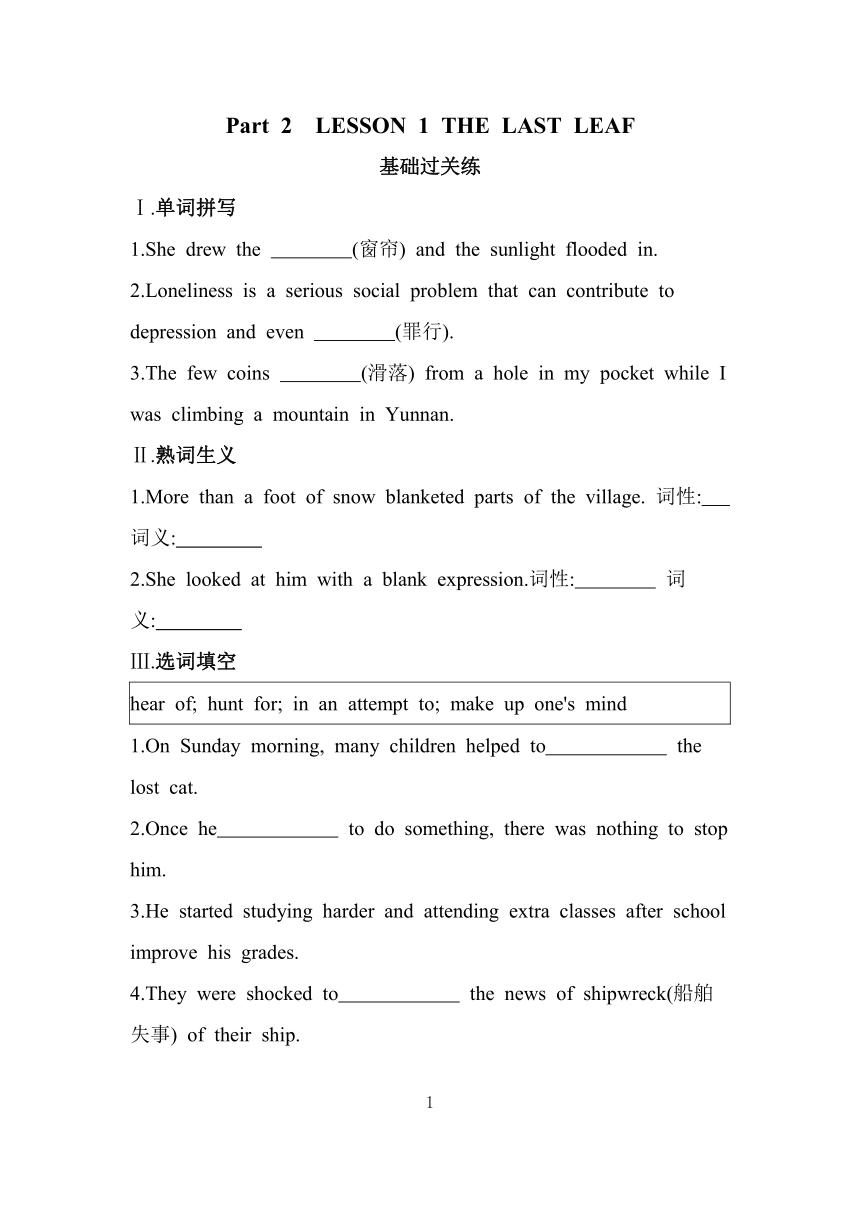
|
|
| 格式 | docx | ||
| 文件大小 | 39.9KB | ||
| 资源类型 | 试卷 | ||
| 版本资源 | 北师大版(2019) | ||
| 科目 | 英语 | ||
| 更新时间 | 2025-12-04 17:23:54 | ||
图片预览

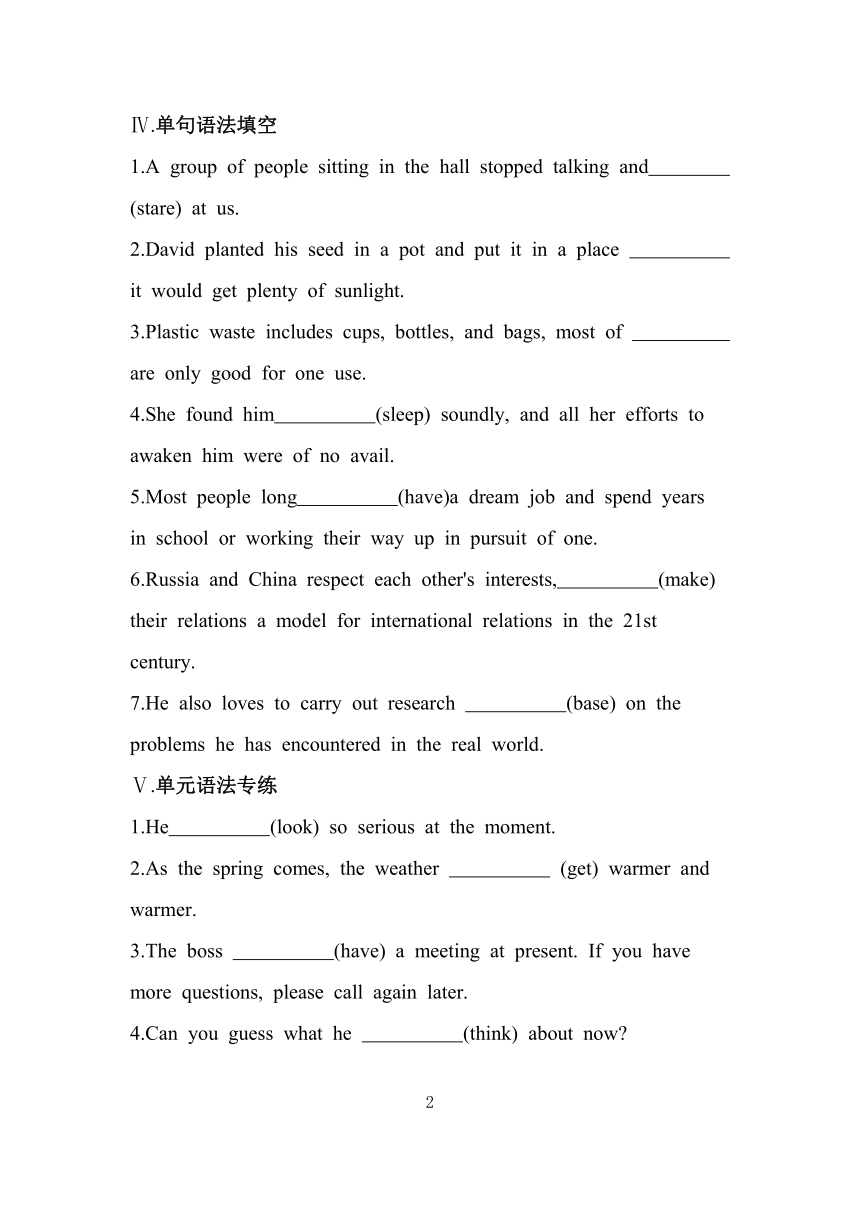
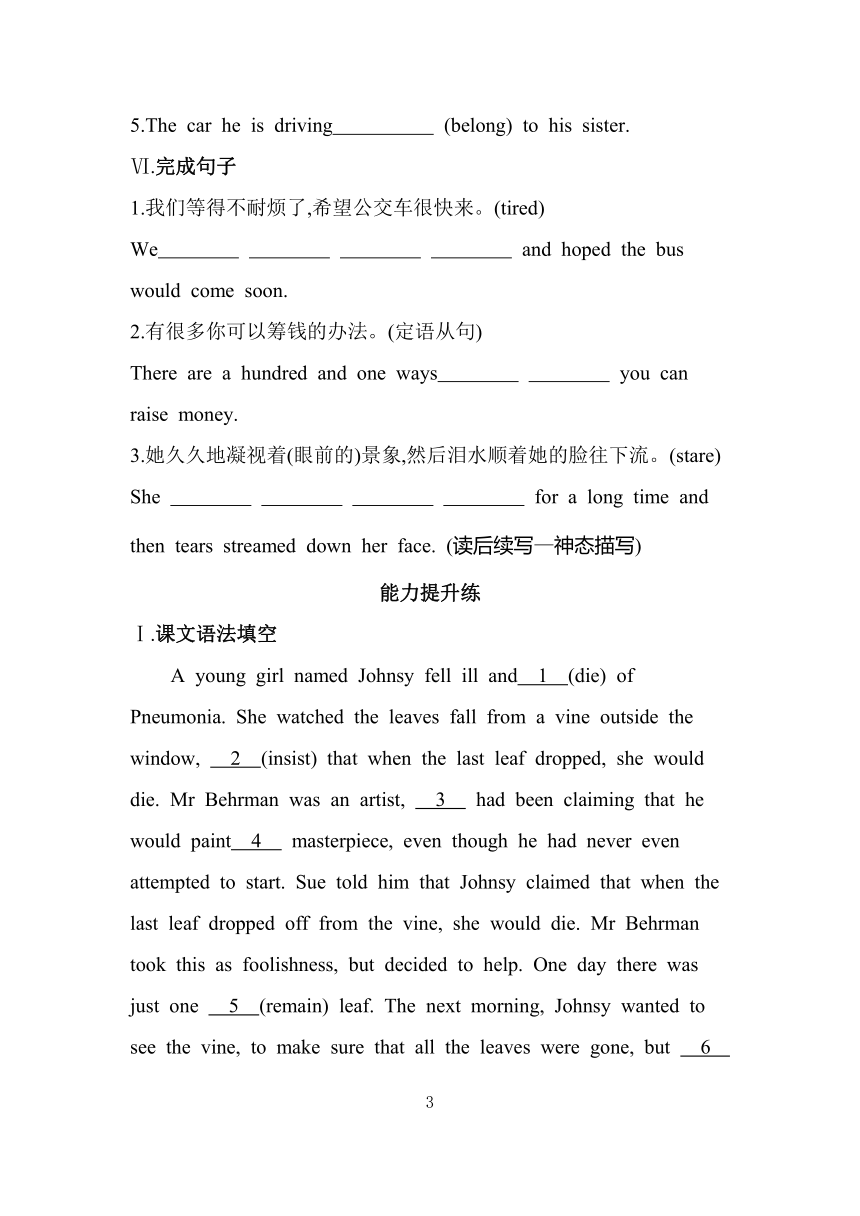
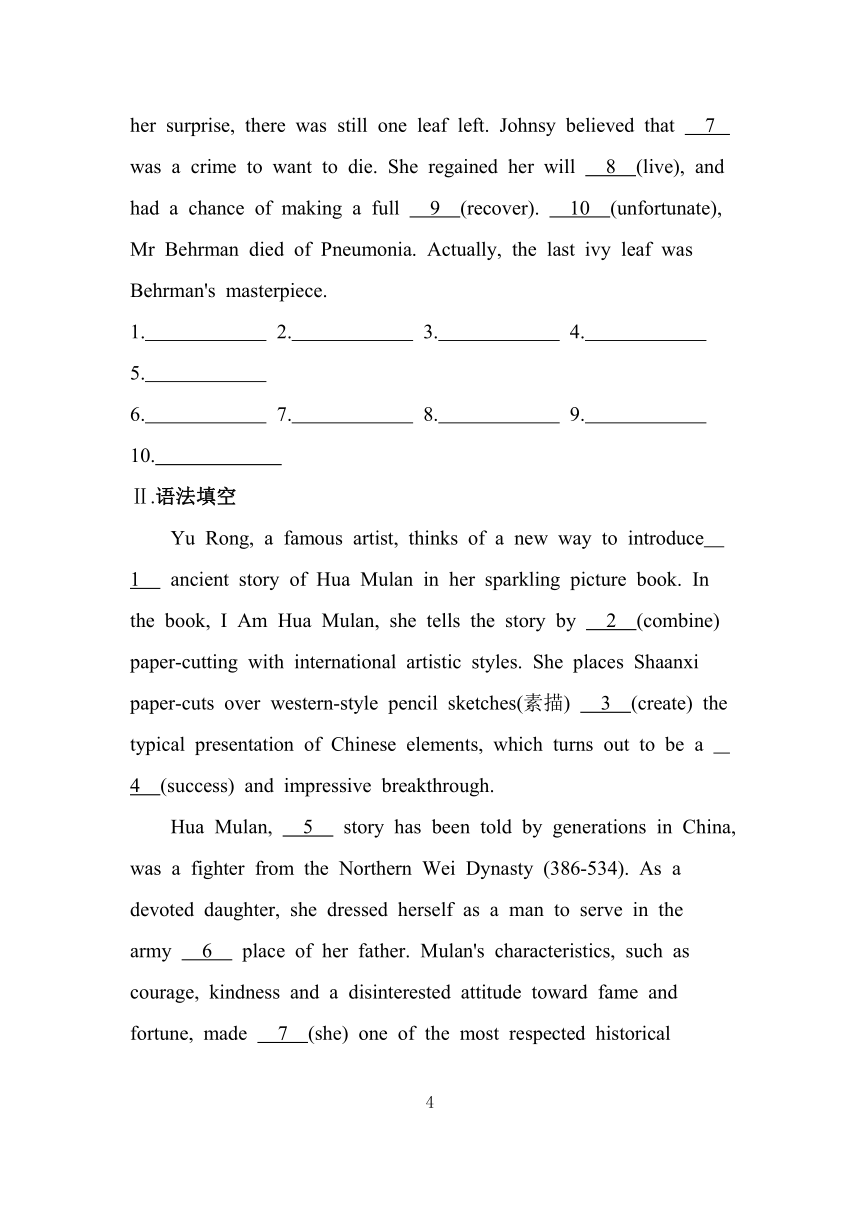
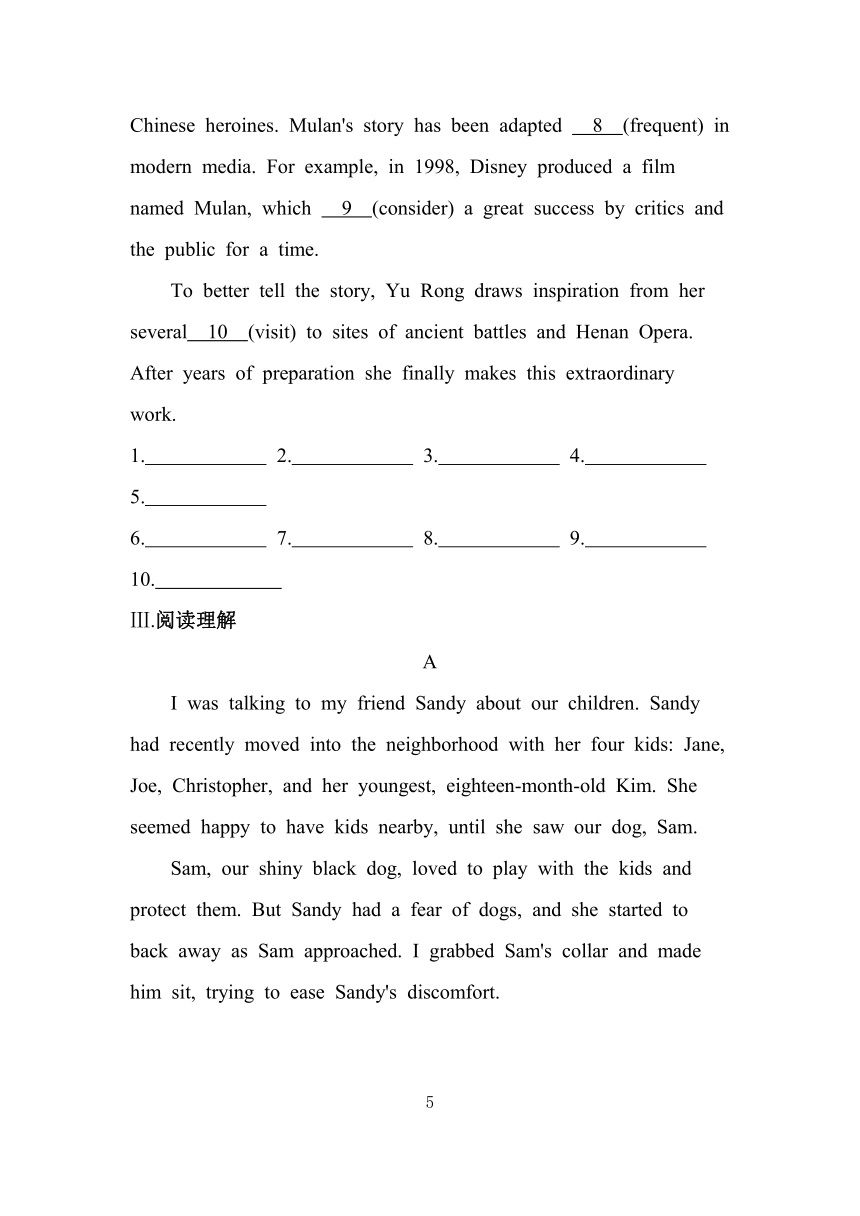
文档简介
Part 2 LESSON 1 THE LAST LEAF
基础过关练
Ⅰ.单词拼写
1.She drew the (窗帘) and the sunlight flooded in.
2.Loneliness is a serious social problem that can contribute to depression and even (罪行).
3.The few coins (滑落) from a hole in my pocket while I was climbing a mountain in Yunnan.
Ⅱ.熟词生义
1.More than a foot of snow blanketed parts of the village. 词性: 词义:
2.She looked at him with a blank expression.词性: 词义:
Ⅲ.选词填空
hear of; hunt for; in an attempt to; make up one's mind
1.On Sunday morning, many children helped to the lost cat.
2.Once he to do something, there was nothing to stop him.
3.He started studying harder and attending extra classes after school improve his grades.
4.They were shocked to the news of shipwreck(船舶失事) of their ship.
Ⅳ.单句语法填空
1.A group of people sitting in the hall stopped talking and (stare) at us.
2.David planted his seed in a pot and put it in a place it would get plenty of sunlight.
3.Plastic waste includes cups, bottles, and bags, most of are only good for one use.
4.She found him (sleep) soundly, and all her efforts to awaken him were of no avail.
5.Most people long (have)a dream job and spend years in school or working their way up in pursuit of one.
6.Russia and China respect each other's interests, (make) their relations a model for international relations in the 21st century.
7.He also loves to carry out research (base) on the problems he has encountered in the real world.
Ⅴ.单元语法专练
1.He (look) so serious at the moment.
2.As the spring comes, the weather (get) warmer and warmer.
3.The boss (have) a meeting at present. If you have more questions, please call again later.
4.Can you guess what he (think) about now
5.The car he is driving (belong) to his sister.
Ⅵ.完成句子
1.我们等得不耐烦了,希望公交车很快来。(tired)
We and hoped the bus would come soon.
2.有很多你可以筹钱的办法。(定语从句)
There are a hundred and one ways you can raise money.
3.她久久地凝视着(眼前的)景象,然后泪水顺着她的脸往下流。(stare)
She for a long time and then tears streamed down her face. (读后续写—神态描写)
能力提升练
Ⅰ.课文语法填空
A young girl named Johnsy fell ill and 1 (die) of Pneumonia. She watched the leaves fall from a vine outside the window, 2 (insist) that when the last leaf dropped, she would die. Mr Behrman was an artist, 3 had been claiming that he would paint 4 masterpiece, even though he had never even attempted to start. Sue told him that Johnsy claimed that when the last leaf dropped off from the vine, she would die. Mr Behrman took this as foolishness, but decided to help. One day there was just one 5 (remain) leaf. The next morning, Johnsy wanted to see the vine, to make sure that all the leaves were gone, but 6 her surprise, there was still one leaf left. Johnsy believed that 7 was a crime to want to die. She regained her will 8 (live), and had a chance of making a full 9 (recover). 10 (unfortunate), Mr Behrman died of Pneumonia. Actually, the last ivy leaf was Behrman's masterpiece.
1. 2. 3. 4. 5.
6. 7. 8. 9. 10.
Ⅱ.语法填空
Yu Rong, a famous artist, thinks of a new way to introduce 1 ancient story of Hua Mulan in her sparkling picture book. In the book, I Am Hua Mulan, she tells the story by 2 (combine) paper-cutting with international artistic styles. She places Shaanxi paper-cuts over western-style pencil sketches(素描) 3 (create) the typical presentation of Chinese elements, which turns out to be a 4 (success) and impressive breakthrough.
Hua Mulan, 5 story has been told by generations in China, was a fighter from the Northern Wei Dynasty (386-534). As a devoted daughter, she dressed herself as a man to serve in the army 6 place of her father. Mulan's characteristics, such as courage, kindness and a disinterested attitude toward fame and fortune, made 7 (she) one of the most respected historical Chinese heroines. Mulan's story has been adapted 8 (frequent) in modern media. For example, in 1998, Disney produced a film named Mulan, which 9 (consider) a great success by critics and the public for a time.
To better tell the story, Yu Rong draws inspiration from her several 10 (visit) to sites of ancient battles and Henan Opera. After years of preparation she finally makes this extraordinary work.
1. 2. 3. 4. 5.
6. 7. 8. 9. 10.
Ⅲ.阅读理解
A
I was talking to my friend Sandy about our children. Sandy had recently moved into the neighborhood with her four kids: Jane, Joe, Christopher, and her youngest, eighteen-month-old Kim. She seemed happy to have kids nearby, until she saw our dog, Sam.
Sam, our shiny black dog, loved to play with the kids and protect them. But Sandy had a fear of dogs, and she started to back away as Sam approached. I grabbed Sam's collar and made him sit, trying to ease Sandy's discomfort.
Sandy mentioned that she needed to get her kids ready to go to their grandmother's house. Just then, her door opened and her kids rushed out. Sandy shouted at them to stay away from Sam.
The kids huddled(挤在一起) around their mom, looking at Sam cautiously(谨慎地). Emma, my daughter, showed the kids how to approach a dog slowly and properly. The kids were won over by Sam's friendly nature, but I knew it would take some time for Sandy to change her viewpoint.
After that incident, we made sure that Sam didn't go near our neighbors without me present. One day, when the kids were playing across the street, I noticed the eighteen-month-old baby heading towards a small hill. I saw a car approaching and shouted at everyone to watch the baby. Without hesitation, Sam rushed out the door and ran across the street towards the baby. He ran to the baby in time to gently push him away from the oncoming car. The kids cheered, completely unaware of the danger. They thought Sam had come to play.
Within a year, Sam had made friends with all the neighbors. Even Sandy started to warm to Sam and would occasionally come over to give him a hug.
1.How did Sandy feel when she first saw Sam
A.Excited. B.Curious. C.Fearful. D.Awkward.
2.What did Sandy's kids do at the sight of Sam
A.They stared at Sam with watchful eyes.
B.They formed a circle to protect their mom.
C.They held Sam by the collar to make him sit.
D.They prepared to escape from the dog.
3.How did Sam save Kim from danger
A.By running in front of the car to block it. B.By rushing to Sandy's house to get help.
C.By pushing the baby away from the car. D.By jumping to the front of the baby.
4.Which of the following can best describe Sam
A.Curious. B.Brave. C.Funny. D.Sensitive.
B
Shakespeare Week is the annual national celebration of Shakespeare in primary schools, organized by the Shakespeare Birthplace Trust. Since its launch in 2014, over eight million primary school children have had first experiences of the world's greatest writer. This year, Shakespeare Week runs from 16 to 22 March and has a theme of art and design. It's free to register and to access hundreds of resources on the Shakespeare Week website, including videos, plays, poetry, storytelling, debate, art and much more, providing children with first experiences of the world's best-known writer.
Create a Shakespeare portrait
We're working with some of the nation's best-loved children's illustrators to contribute a portrait of William Shakespeare. Participants can see their artworks in an absorbing online exhibition. They can imagine their own William Shakespeare, plan and decide how they would like to represent him. Here are some suggestions:
Make an abstract Shakespeare, draw a sketch of Shakespeare and then use a tablet to take photographs of the portrait. Create a selection of images that show a range of thoughts and emotions.
Children can enter their Shakespeare portraits in a competition to win the chance to have their works exhibited during Shakespeare Week. They will also receive an art workshop for their class from great artists.
Recreate Shakespeare's hometown
Some of the buildings that Shakespeare would have walked past and indeed lived in are still standing in Stratford-upon-Avon. If you can't make it, why not recreate a miniature(微型的)Stratford-upon-Avon We offer a simple art activity created for Shakespeare Week by artist Jennie Maizels. Children can follow her step-by-step video and use the downloadable resources free on the website. It is a simple but effective tracing and copying activity, exploring watercolor and fine line pen painting and drawing techniques.
Design a story world
Participants can work with other children to design a “narrative environment” or “story world” that picks out a key or magical moment from one of Shakespeare's stories. This will offer them a great chance to explore Shakespeare's world.
Why not take your children to join us You won't regret it!
5.What can we know about Shakespeare Week
A.It requires a registration fee. B.It has a history of more than 15 years.
C.It is a yearly competition about Shakespeare. D.It offers learning materials about Shakespeare.
6.If someone wins in the Shakespeare portrait contest, what can he do
A.He can meet with popular illustrators. B.He can have his work shown in public.
C.He can run an art workshop for his class. D.He can visit Shakespeare's birthplace for free.
7.Who is the article mainly intended for
A.Parents with kids. B.Art students.
C.Shakespeare's fans. D.Newspaper journalists.
Part 2 LESSON 1 THE LAST LEAF
基础过关练
Ⅰ.1.curtain(s) 2.crimes 3.slipped
Ⅱ.1.动词;覆盖 句意:一英尺多厚的白雪覆盖了这个村庄的部分区域。
2.形容词;茫然的 句意:她茫然地看着他。
Ⅲ.1.hunt for 2.made up his mind 3.in an attempt to 4.hear of
Ⅳ.1.stared 考查时态。句意:坐在大厅里的一群人停止了谈话,盯着我们看。由空前的and可知前后构成并列关系,分析句子可知,填入词与stopped并列作谓语,时态均为一般过去时,故填stared。
2.where 考查定语从句。句意:戴维把他的种子种在一个花盆里,并把它放在阳光充足的地方。分析句子可知,设空处引导定语从句,在从句中作状语,因先行词为place,故填表地点的关系副词where。
3.which 考查定语从句。句意:塑料垃圾包括杯子、瓶子和袋子,其中大多数(东西)只能使用一次。分析句子结构可知,most of are only good for one use为非限制性定语从句,先行词为cups, bottles, and bags,指物,在从句中作介词of的宾语,所以此处用关系代词which。故填which。
4.sleeping 考查现在分词。句意:她发现他睡得很沉,她想唤醒他的一切努力都无济于事。设空处作宾语补足语,由于宾语him与sleep之间为逻辑上的主动关系,且表示动作正在进行,故使用现在分词sleeping。
5.to have 考查动词不定式。long to do sth.表示“渴望做某事”,故填to have。
6.making 考查现在分词。句意:俄罗斯和中国相互尊重对方的利益,这使两国关系成为21世纪国际关系的典范。结合句意判断逗号后面的部分作结果状语,且为顺理成章的结果,逗号前面的内容与make存在逻辑上的主动关系,应用现在分词,故填making。
7.based 考查过去分词。句意:他还喜欢根据自己在现实世界中遇到的问题进行研究。主句的谓语动词是loves,设空处应用非谓语动词,base与其逻辑主语research之间是被动关系,应用过去分词作后置定语。(be) based on表示“根据”,故填based。
Ⅴ.1.looks 考查动词时态。句意:他现在看上去很严肃。look在这里是状态动词,根据at the moment可知用一般现在时,且主语为第三人称单数,谓语动词应用第三人称单数,故填looks。
2.is getting 考查动词时态。 句意:随着春天的到来,天气变得越来越暖和。由时间状语从句中谓语动词的时态可知主句用现在时,天气变得越来越暖和,表示正在进行,故填is getting。
3.is having 考查动词时态。句意:老板现在正在开会。如果你还有问题的话,请晚些时候再打电话。根据at present和句意可知用现在进行时,故填is having。
4.is thinking 考查动词时态。句意:你能猜出来他现在正在想什么吗 此处表示现在正在想,所以用现在进行时,宾语从句的主语是he,为第三人称单数,谓语动词应用第三人称单数,故填is thinking。
5.belongs 考查动词时态。句意:他正在开的汽车属于他的姐姐。此处陈述一般情况,应用一般现在时,belong 是状态动词,主句主语The car是单数名词,主句谓语动词应用第三人称单数,故填belongs。
Ⅵ.1.were tired of waiting 2.in which 3.stared at the scene
能力提升练
Ⅰ.1.was dying 考查时态。句意:一个名叫约翰西的年轻女孩得了肺炎,快要死了。根据下文“when...she would die”判断此处表示“将死,垂死”,表示准备好要做的事,所以用过去进行时表过去将来,故填was dying。
2.insisting 考查现在分词。句意:她看着窗外的葡萄藤上的叶子掉落,坚持说当最后一片叶子掉落,她就会死。分析可知,逗号前为完整的句子,句中无并列连词,所以逗号后为状语,insist的逻辑主语是主句的主语She,两者之间是主动关系,应用现在分词,故填insisting。
3.who 考查定语从句。句意:伯曼先生是一位画家,他一直声称他将画一幅杰作,尽管他甚至从来没有尝试开始过。分析句子可知此处是非限制性定语从句,先行词为an artist,指人,设空处引导非限制性定语从句且在从句中作主语,故填who。
4.a 考查冠词。空前为动词paint,空后为可数名词的单数形式,所以此处缺少冠词,且为泛指,masterpiece以辅音音素开头,故用不定冠词a。
5.remaining 考查形容词。句意:一天,只剩下一片叶子了。设空处作定语,修饰leaf,应用形容词,此处应填remaining,表示“剩余的”。
6.to 考查介词。句意:第二天早上,约翰西想看看葡萄藤,以确定所有的叶子都没有了,但令她惊讶的是,还剩下一片叶子。to one's surprise意为“让某人惊讶的是”,故填to。
7.it 考查it的用法。句意:约翰西认为想死是一种罪过。分析句子可知that引导宾语从句,从句为“it is+名词+to do sth.”句型,其中it为形式主语,不定式为真正的主语,即此处真正的主语是to want to die,故用it作形式主语。
8.to live 考查动词不定式。句意:她恢复了生存的意志,有完全康复的机会。结合句意判断,此处will为名词,设空处作will的后置定语,故用不定式to live。
9.recovery 考查名词。分析句子可知设空处作making的宾语,再结合空前的不定冠词a和形容词full可判断此处应用名词,故填recovery。
10.Unfortunately 考查副词。句意:不幸的是,伯曼先生死于肺炎。设空处修饰整个句子,应用副词,句首单词首字母应大写,故填Unfortunately。
Ⅱ.◎语篇解读 本文是一篇记叙文。为了更好地诠释花木兰的故事,艺术家郁蓉把剪纸艺术和这个故事结合了起来。
1.the 考查冠词。空后的story为可数名词,前面应有冠词,此处特指花木兰的故事,应使用定冠词,故填the。
2.combining 考查动名词。句意:在《我是花木兰》这本书中,她通过把剪纸和国际艺术风格结合起来讲述这个故事。空前为介词by,此处表示“通过……”,后面应使用动名词,故填combining。
3.to create 考查动词不定式。此处表示目的,应使用动词不定式,故填to create。
4.successful 考查形容词。由空后并列连词and和形容词impressive可知,此处应用形容词,修饰breakthrough,故填successful。
5.whose 考查定语从句。句意:花木兰是北魏(386—534)的一个战士,她的故事在中国代代相传。分析句子可知,两个逗号中间为非限制性定语从句,故此空应为定语从句的引导词,定语从句的先行词是Hua Mulan,与story之间存在所属关系,应用关系代词whose。
6.in 考查介词。分析句子结构可知,此处用介词短语作状语,in place of表示“代替”,故填in。
7.her 考查代词。句意:木兰的勇气、善良和对名利的漠视态度等品质使她成为中国历史上最受尊敬的女英雄之一。分析句子可知,此处作动词made的宾语,应使用代词宾格her,one of the most respected historical Chinese heroines为宾语补足语,故填her。
8.frequently 考查副词。设空处修饰谓语has been adapted,应该用副词,故填frequently。
9.was considered 考查时态、语态和主谓一致。句意:例如,1998年,迪士尼制作了一部名叫《花木兰》的电影,这部电影一度被评论家和公众视为巨大的成功。分析句子结构可判断,设空处为非限制性定语从句的谓语动词,主语which(指代先行词Mulan)与consider之间存在被动关系,根据in 1998和for a time可知应用一般过去时的被动语态,先行词Mulan为单数意义,故填was considered。
10.visits 考查名词复数。句意:为了更好地讲述这个故事,郁蓉从她对古代战争旧址的几次访问以及豫剧中获得灵感。visit为可数名词,被several修饰,故用其复数形式visits。
【高频词汇】 1.presentation n.呈现方式 2.element n.元素 3.turn out证明是;结果是 4.impressive adj.使人印象深刻的 5.breakthrough n.突破 6.fame and fortune名利 7.inspiration n.灵感
Ⅲ. A
◎语篇解读 本文是一篇记叙文。文章讲述了新邻居家的女主人桑迪很怕作者家的狗——萨姆,但是后来萨姆在关键时刻救了桑迪的孩子,从此桑迪改变了对萨姆的看法,萨姆也成了邻居的好朋友。
1.C 细节理解题。根据第二段第二句“But Sandy had a fear of dogs, and she started to back away as Sam approached.”可知,桑迪第一次见到萨姆时很害怕。故选C项。
2.A 细节理解题。根据第四段第一句“The kids huddled(挤在一起) around their mom, looking at Sam cautiously(谨慎地).”可知,桑迪的孩子们看到萨姆的时候都非常警惕地注视着它。故选A项。
3.C 细节理解题。根据第五段第五句“He ran to the baby in time to gently push him away from the oncoming car.”可知,萨姆把他推离汽车,让他脱离了危险。故选C项。
4.B 推理判断题。根据第五段第四、五句“Without hesitation, Sam rushed out the door and ran across the street towards the baby. He ran to the baby in time to gently push him away from the oncoming car.”可知,萨姆毫不犹豫地从危险中救出了孩子,由此推断萨姆很勇敢。故选B项。
【高频词汇】 1.approach v.靠近,接近 n.靠近;方式 2.incident n.事件 3.without hesitation毫不犹豫地
4.completely adv.彻底地,完全地 5.unaware adj.未意识到的 6.occasionally adv.偶尔,有时候
【熟词生义】 nature n.本性
B
◎语篇解读 本文是一篇说明文。文章主要介绍了莎士比亚周。莎士比亚周是莎士比亚出生地信托基金会在小学举办的一年一度的全国性莎士比亚纪念活动。
5.D 细节理解题。根据第一段中的“It's free to register and to access hundreds of resources on the Shakespeare Week website...providing children with first experiences of the world's best-known writer.”可知,注册是免费的,你可以在“莎士比亚周”网站上免费获得数百种资源,这给孩子们提供了关于这位世界上最著名的作家的初步体验,故选D。注册是免费的,故排除A项;由第一段中的“Since its launch in 2014”可知,这个活动的历史不到十五年,故排除B项。
易错归因
本题易错选C项。由第一段首句中celebration一词可知这是一个庆祝活动,不是比赛,文中提到的competition只是庆祝活动中的一项,故排除C项。
6.B 细节理解题。根据Create a Shakespeare portrait部分中的“Children can enter their Shakespeare portraits in a competition to win the chance to have their works exhibited during Shakespeare Week.”可知,莎士比亚肖像比赛中的获胜者会获得公开展出自己的作品的机会。故选B。
7.A 推理判断题。根据第一段中的“Shakespeare Week is the annual national celebration of Shakespeare in primary schools”和最后一段中的“Why not take your children to join us ”可推知,这篇文章是为有孩子的父母写的。故选A。
【高频词汇】 1.launch n.发起 2.access vt.使用;进入;获取 3.resource n.资源 4.portrait n.肖像 5.represent vt.展示;描绘;代表,象征 6.a range of一系列
【熟词生义】 run vi.持续,延续
【差距词汇】 1.illustrator n.插图画家 2.sketch n.素描,速写 3.narrative adj.叙事的
5
基础过关练
Ⅰ.单词拼写
1.She drew the (窗帘) and the sunlight flooded in.
2.Loneliness is a serious social problem that can contribute to depression and even (罪行).
3.The few coins (滑落) from a hole in my pocket while I was climbing a mountain in Yunnan.
Ⅱ.熟词生义
1.More than a foot of snow blanketed parts of the village. 词性: 词义:
2.She looked at him with a blank expression.词性: 词义:
Ⅲ.选词填空
hear of; hunt for; in an attempt to; make up one's mind
1.On Sunday morning, many children helped to the lost cat.
2.Once he to do something, there was nothing to stop him.
3.He started studying harder and attending extra classes after school improve his grades.
4.They were shocked to the news of shipwreck(船舶失事) of their ship.
Ⅳ.单句语法填空
1.A group of people sitting in the hall stopped talking and (stare) at us.
2.David planted his seed in a pot and put it in a place it would get plenty of sunlight.
3.Plastic waste includes cups, bottles, and bags, most of are only good for one use.
4.She found him (sleep) soundly, and all her efforts to awaken him were of no avail.
5.Most people long (have)a dream job and spend years in school or working their way up in pursuit of one.
6.Russia and China respect each other's interests, (make) their relations a model for international relations in the 21st century.
7.He also loves to carry out research (base) on the problems he has encountered in the real world.
Ⅴ.单元语法专练
1.He (look) so serious at the moment.
2.As the spring comes, the weather (get) warmer and warmer.
3.The boss (have) a meeting at present. If you have more questions, please call again later.
4.Can you guess what he (think) about now
5.The car he is driving (belong) to his sister.
Ⅵ.完成句子
1.我们等得不耐烦了,希望公交车很快来。(tired)
We and hoped the bus would come soon.
2.有很多你可以筹钱的办法。(定语从句)
There are a hundred and one ways you can raise money.
3.她久久地凝视着(眼前的)景象,然后泪水顺着她的脸往下流。(stare)
She for a long time and then tears streamed down her face. (读后续写—神态描写)
能力提升练
Ⅰ.课文语法填空
A young girl named Johnsy fell ill and 1 (die) of Pneumonia. She watched the leaves fall from a vine outside the window, 2 (insist) that when the last leaf dropped, she would die. Mr Behrman was an artist, 3 had been claiming that he would paint 4 masterpiece, even though he had never even attempted to start. Sue told him that Johnsy claimed that when the last leaf dropped off from the vine, she would die. Mr Behrman took this as foolishness, but decided to help. One day there was just one 5 (remain) leaf. The next morning, Johnsy wanted to see the vine, to make sure that all the leaves were gone, but 6 her surprise, there was still one leaf left. Johnsy believed that 7 was a crime to want to die. She regained her will 8 (live), and had a chance of making a full 9 (recover). 10 (unfortunate), Mr Behrman died of Pneumonia. Actually, the last ivy leaf was Behrman's masterpiece.
1. 2. 3. 4. 5.
6. 7. 8. 9. 10.
Ⅱ.语法填空
Yu Rong, a famous artist, thinks of a new way to introduce 1 ancient story of Hua Mulan in her sparkling picture book. In the book, I Am Hua Mulan, she tells the story by 2 (combine) paper-cutting with international artistic styles. She places Shaanxi paper-cuts over western-style pencil sketches(素描) 3 (create) the typical presentation of Chinese elements, which turns out to be a 4 (success) and impressive breakthrough.
Hua Mulan, 5 story has been told by generations in China, was a fighter from the Northern Wei Dynasty (386-534). As a devoted daughter, she dressed herself as a man to serve in the army 6 place of her father. Mulan's characteristics, such as courage, kindness and a disinterested attitude toward fame and fortune, made 7 (she) one of the most respected historical Chinese heroines. Mulan's story has been adapted 8 (frequent) in modern media. For example, in 1998, Disney produced a film named Mulan, which 9 (consider) a great success by critics and the public for a time.
To better tell the story, Yu Rong draws inspiration from her several 10 (visit) to sites of ancient battles and Henan Opera. After years of preparation she finally makes this extraordinary work.
1. 2. 3. 4. 5.
6. 7. 8. 9. 10.
Ⅲ.阅读理解
A
I was talking to my friend Sandy about our children. Sandy had recently moved into the neighborhood with her four kids: Jane, Joe, Christopher, and her youngest, eighteen-month-old Kim. She seemed happy to have kids nearby, until she saw our dog, Sam.
Sam, our shiny black dog, loved to play with the kids and protect them. But Sandy had a fear of dogs, and she started to back away as Sam approached. I grabbed Sam's collar and made him sit, trying to ease Sandy's discomfort.
Sandy mentioned that she needed to get her kids ready to go to their grandmother's house. Just then, her door opened and her kids rushed out. Sandy shouted at them to stay away from Sam.
The kids huddled(挤在一起) around their mom, looking at Sam cautiously(谨慎地). Emma, my daughter, showed the kids how to approach a dog slowly and properly. The kids were won over by Sam's friendly nature, but I knew it would take some time for Sandy to change her viewpoint.
After that incident, we made sure that Sam didn't go near our neighbors without me present. One day, when the kids were playing across the street, I noticed the eighteen-month-old baby heading towards a small hill. I saw a car approaching and shouted at everyone to watch the baby. Without hesitation, Sam rushed out the door and ran across the street towards the baby. He ran to the baby in time to gently push him away from the oncoming car. The kids cheered, completely unaware of the danger. They thought Sam had come to play.
Within a year, Sam had made friends with all the neighbors. Even Sandy started to warm to Sam and would occasionally come over to give him a hug.
1.How did Sandy feel when she first saw Sam
A.Excited. B.Curious. C.Fearful. D.Awkward.
2.What did Sandy's kids do at the sight of Sam
A.They stared at Sam with watchful eyes.
B.They formed a circle to protect their mom.
C.They held Sam by the collar to make him sit.
D.They prepared to escape from the dog.
3.How did Sam save Kim from danger
A.By running in front of the car to block it. B.By rushing to Sandy's house to get help.
C.By pushing the baby away from the car. D.By jumping to the front of the baby.
4.Which of the following can best describe Sam
A.Curious. B.Brave. C.Funny. D.Sensitive.
B
Shakespeare Week is the annual national celebration of Shakespeare in primary schools, organized by the Shakespeare Birthplace Trust. Since its launch in 2014, over eight million primary school children have had first experiences of the world's greatest writer. This year, Shakespeare Week runs from 16 to 22 March and has a theme of art and design. It's free to register and to access hundreds of resources on the Shakespeare Week website, including videos, plays, poetry, storytelling, debate, art and much more, providing children with first experiences of the world's best-known writer.
Create a Shakespeare portrait
We're working with some of the nation's best-loved children's illustrators to contribute a portrait of William Shakespeare. Participants can see their artworks in an absorbing online exhibition. They can imagine their own William Shakespeare, plan and decide how they would like to represent him. Here are some suggestions:
Make an abstract Shakespeare, draw a sketch of Shakespeare and then use a tablet to take photographs of the portrait. Create a selection of images that show a range of thoughts and emotions.
Children can enter their Shakespeare portraits in a competition to win the chance to have their works exhibited during Shakespeare Week. They will also receive an art workshop for their class from great artists.
Recreate Shakespeare's hometown
Some of the buildings that Shakespeare would have walked past and indeed lived in are still standing in Stratford-upon-Avon. If you can't make it, why not recreate a miniature(微型的)Stratford-upon-Avon We offer a simple art activity created for Shakespeare Week by artist Jennie Maizels. Children can follow her step-by-step video and use the downloadable resources free on the website. It is a simple but effective tracing and copying activity, exploring watercolor and fine line pen painting and drawing techniques.
Design a story world
Participants can work with other children to design a “narrative environment” or “story world” that picks out a key or magical moment from one of Shakespeare's stories. This will offer them a great chance to explore Shakespeare's world.
Why not take your children to join us You won't regret it!
5.What can we know about Shakespeare Week
A.It requires a registration fee. B.It has a history of more than 15 years.
C.It is a yearly competition about Shakespeare. D.It offers learning materials about Shakespeare.
6.If someone wins in the Shakespeare portrait contest, what can he do
A.He can meet with popular illustrators. B.He can have his work shown in public.
C.He can run an art workshop for his class. D.He can visit Shakespeare's birthplace for free.
7.Who is the article mainly intended for
A.Parents with kids. B.Art students.
C.Shakespeare's fans. D.Newspaper journalists.
Part 2 LESSON 1 THE LAST LEAF
基础过关练
Ⅰ.1.curtain(s) 2.crimes 3.slipped
Ⅱ.1.动词;覆盖 句意:一英尺多厚的白雪覆盖了这个村庄的部分区域。
2.形容词;茫然的 句意:她茫然地看着他。
Ⅲ.1.hunt for 2.made up his mind 3.in an attempt to 4.hear of
Ⅳ.1.stared 考查时态。句意:坐在大厅里的一群人停止了谈话,盯着我们看。由空前的and可知前后构成并列关系,分析句子可知,填入词与stopped并列作谓语,时态均为一般过去时,故填stared。
2.where 考查定语从句。句意:戴维把他的种子种在一个花盆里,并把它放在阳光充足的地方。分析句子可知,设空处引导定语从句,在从句中作状语,因先行词为place,故填表地点的关系副词where。
3.which 考查定语从句。句意:塑料垃圾包括杯子、瓶子和袋子,其中大多数(东西)只能使用一次。分析句子结构可知,most of are only good for one use为非限制性定语从句,先行词为cups, bottles, and bags,指物,在从句中作介词of的宾语,所以此处用关系代词which。故填which。
4.sleeping 考查现在分词。句意:她发现他睡得很沉,她想唤醒他的一切努力都无济于事。设空处作宾语补足语,由于宾语him与sleep之间为逻辑上的主动关系,且表示动作正在进行,故使用现在分词sleeping。
5.to have 考查动词不定式。long to do sth.表示“渴望做某事”,故填to have。
6.making 考查现在分词。句意:俄罗斯和中国相互尊重对方的利益,这使两国关系成为21世纪国际关系的典范。结合句意判断逗号后面的部分作结果状语,且为顺理成章的结果,逗号前面的内容与make存在逻辑上的主动关系,应用现在分词,故填making。
7.based 考查过去分词。句意:他还喜欢根据自己在现实世界中遇到的问题进行研究。主句的谓语动词是loves,设空处应用非谓语动词,base与其逻辑主语research之间是被动关系,应用过去分词作后置定语。(be) based on表示“根据”,故填based。
Ⅴ.1.looks 考查动词时态。句意:他现在看上去很严肃。look在这里是状态动词,根据at the moment可知用一般现在时,且主语为第三人称单数,谓语动词应用第三人称单数,故填looks。
2.is getting 考查动词时态。 句意:随着春天的到来,天气变得越来越暖和。由时间状语从句中谓语动词的时态可知主句用现在时,天气变得越来越暖和,表示正在进行,故填is getting。
3.is having 考查动词时态。句意:老板现在正在开会。如果你还有问题的话,请晚些时候再打电话。根据at present和句意可知用现在进行时,故填is having。
4.is thinking 考查动词时态。句意:你能猜出来他现在正在想什么吗 此处表示现在正在想,所以用现在进行时,宾语从句的主语是he,为第三人称单数,谓语动词应用第三人称单数,故填is thinking。
5.belongs 考查动词时态。句意:他正在开的汽车属于他的姐姐。此处陈述一般情况,应用一般现在时,belong 是状态动词,主句主语The car是单数名词,主句谓语动词应用第三人称单数,故填belongs。
Ⅵ.1.were tired of waiting 2.in which 3.stared at the scene
能力提升练
Ⅰ.1.was dying 考查时态。句意:一个名叫约翰西的年轻女孩得了肺炎,快要死了。根据下文“when...she would die”判断此处表示“将死,垂死”,表示准备好要做的事,所以用过去进行时表过去将来,故填was dying。
2.insisting 考查现在分词。句意:她看着窗外的葡萄藤上的叶子掉落,坚持说当最后一片叶子掉落,她就会死。分析可知,逗号前为完整的句子,句中无并列连词,所以逗号后为状语,insist的逻辑主语是主句的主语She,两者之间是主动关系,应用现在分词,故填insisting。
3.who 考查定语从句。句意:伯曼先生是一位画家,他一直声称他将画一幅杰作,尽管他甚至从来没有尝试开始过。分析句子可知此处是非限制性定语从句,先行词为an artist,指人,设空处引导非限制性定语从句且在从句中作主语,故填who。
4.a 考查冠词。空前为动词paint,空后为可数名词的单数形式,所以此处缺少冠词,且为泛指,masterpiece以辅音音素开头,故用不定冠词a。
5.remaining 考查形容词。句意:一天,只剩下一片叶子了。设空处作定语,修饰leaf,应用形容词,此处应填remaining,表示“剩余的”。
6.to 考查介词。句意:第二天早上,约翰西想看看葡萄藤,以确定所有的叶子都没有了,但令她惊讶的是,还剩下一片叶子。to one's surprise意为“让某人惊讶的是”,故填to。
7.it 考查it的用法。句意:约翰西认为想死是一种罪过。分析句子可知that引导宾语从句,从句为“it is+名词+to do sth.”句型,其中it为形式主语,不定式为真正的主语,即此处真正的主语是to want to die,故用it作形式主语。
8.to live 考查动词不定式。句意:她恢复了生存的意志,有完全康复的机会。结合句意判断,此处will为名词,设空处作will的后置定语,故用不定式to live。
9.recovery 考查名词。分析句子可知设空处作making的宾语,再结合空前的不定冠词a和形容词full可判断此处应用名词,故填recovery。
10.Unfortunately 考查副词。句意:不幸的是,伯曼先生死于肺炎。设空处修饰整个句子,应用副词,句首单词首字母应大写,故填Unfortunately。
Ⅱ.◎语篇解读 本文是一篇记叙文。为了更好地诠释花木兰的故事,艺术家郁蓉把剪纸艺术和这个故事结合了起来。
1.the 考查冠词。空后的story为可数名词,前面应有冠词,此处特指花木兰的故事,应使用定冠词,故填the。
2.combining 考查动名词。句意:在《我是花木兰》这本书中,她通过把剪纸和国际艺术风格结合起来讲述这个故事。空前为介词by,此处表示“通过……”,后面应使用动名词,故填combining。
3.to create 考查动词不定式。此处表示目的,应使用动词不定式,故填to create。
4.successful 考查形容词。由空后并列连词and和形容词impressive可知,此处应用形容词,修饰breakthrough,故填successful。
5.whose 考查定语从句。句意:花木兰是北魏(386—534)的一个战士,她的故事在中国代代相传。分析句子可知,两个逗号中间为非限制性定语从句,故此空应为定语从句的引导词,定语从句的先行词是Hua Mulan,与story之间存在所属关系,应用关系代词whose。
6.in 考查介词。分析句子结构可知,此处用介词短语作状语,in place of表示“代替”,故填in。
7.her 考查代词。句意:木兰的勇气、善良和对名利的漠视态度等品质使她成为中国历史上最受尊敬的女英雄之一。分析句子可知,此处作动词made的宾语,应使用代词宾格her,one of the most respected historical Chinese heroines为宾语补足语,故填her。
8.frequently 考查副词。设空处修饰谓语has been adapted,应该用副词,故填frequently。
9.was considered 考查时态、语态和主谓一致。句意:例如,1998年,迪士尼制作了一部名叫《花木兰》的电影,这部电影一度被评论家和公众视为巨大的成功。分析句子结构可判断,设空处为非限制性定语从句的谓语动词,主语which(指代先行词Mulan)与consider之间存在被动关系,根据in 1998和for a time可知应用一般过去时的被动语态,先行词Mulan为单数意义,故填was considered。
10.visits 考查名词复数。句意:为了更好地讲述这个故事,郁蓉从她对古代战争旧址的几次访问以及豫剧中获得灵感。visit为可数名词,被several修饰,故用其复数形式visits。
【高频词汇】 1.presentation n.呈现方式 2.element n.元素 3.turn out证明是;结果是 4.impressive adj.使人印象深刻的 5.breakthrough n.突破 6.fame and fortune名利 7.inspiration n.灵感
Ⅲ. A
◎语篇解读 本文是一篇记叙文。文章讲述了新邻居家的女主人桑迪很怕作者家的狗——萨姆,但是后来萨姆在关键时刻救了桑迪的孩子,从此桑迪改变了对萨姆的看法,萨姆也成了邻居的好朋友。
1.C 细节理解题。根据第二段第二句“But Sandy had a fear of dogs, and she started to back away as Sam approached.”可知,桑迪第一次见到萨姆时很害怕。故选C项。
2.A 细节理解题。根据第四段第一句“The kids huddled(挤在一起) around their mom, looking at Sam cautiously(谨慎地).”可知,桑迪的孩子们看到萨姆的时候都非常警惕地注视着它。故选A项。
3.C 细节理解题。根据第五段第五句“He ran to the baby in time to gently push him away from the oncoming car.”可知,萨姆把他推离汽车,让他脱离了危险。故选C项。
4.B 推理判断题。根据第五段第四、五句“Without hesitation, Sam rushed out the door and ran across the street towards the baby. He ran to the baby in time to gently push him away from the oncoming car.”可知,萨姆毫不犹豫地从危险中救出了孩子,由此推断萨姆很勇敢。故选B项。
【高频词汇】 1.approach v.靠近,接近 n.靠近;方式 2.incident n.事件 3.without hesitation毫不犹豫地
4.completely adv.彻底地,完全地 5.unaware adj.未意识到的 6.occasionally adv.偶尔,有时候
【熟词生义】 nature n.本性
B
◎语篇解读 本文是一篇说明文。文章主要介绍了莎士比亚周。莎士比亚周是莎士比亚出生地信托基金会在小学举办的一年一度的全国性莎士比亚纪念活动。
5.D 细节理解题。根据第一段中的“It's free to register and to access hundreds of resources on the Shakespeare Week website...providing children with first experiences of the world's best-known writer.”可知,注册是免费的,你可以在“莎士比亚周”网站上免费获得数百种资源,这给孩子们提供了关于这位世界上最著名的作家的初步体验,故选D。注册是免费的,故排除A项;由第一段中的“Since its launch in 2014”可知,这个活动的历史不到十五年,故排除B项。
易错归因
本题易错选C项。由第一段首句中celebration一词可知这是一个庆祝活动,不是比赛,文中提到的competition只是庆祝活动中的一项,故排除C项。
6.B 细节理解题。根据Create a Shakespeare portrait部分中的“Children can enter their Shakespeare portraits in a competition to win the chance to have their works exhibited during Shakespeare Week.”可知,莎士比亚肖像比赛中的获胜者会获得公开展出自己的作品的机会。故选B。
7.A 推理判断题。根据第一段中的“Shakespeare Week is the annual national celebration of Shakespeare in primary schools”和最后一段中的“Why not take your children to join us ”可推知,这篇文章是为有孩子的父母写的。故选A。
【高频词汇】 1.launch n.发起 2.access vt.使用;进入;获取 3.resource n.资源 4.portrait n.肖像 5.represent vt.展示;描绘;代表,象征 6.a range of一系列
【熟词生义】 run vi.持续,延续
【差距词汇】 1.illustrator n.插图画家 2.sketch n.素描,速写 3.narrative adj.叙事的
5
